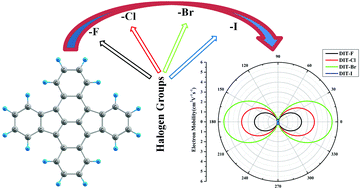Computational study of electron transport in halogen incorporated diindenotetracene compounds: crystal structure, charge transport and optoelectronic properties†
Abstract
The crystal structure, charge transport and optoelectronic properties of newly designed air-stable halogenated diindenotetracene (DIT) based OSCs are reported in this article. The structural, electronic and charge transport properties of the compounds are investigated using density functional theory (DFT) formalism. The air-stability and n-type characteristics are validated from their low lying LUMO energies (<−3.9 eV) and large electron affinity (EA) values (>3.0 eV). Compared with the parent DIT, the designed DIT-X compounds (except for DIT-I) exhibit larger electronic coupling (Ve is found to be ∼1.5 times larger than that of the bare DIT) and higher electron mobilities because of the effect of electron-withdrawing groups substituted at the peripheral positions of the DIT derivatives. The designed DIT-X compounds (except DIT-I) show high electron mobilities (∼2.4–5.4 cm2 V−1 s−1), implying that the compounds can serve as promising electron transport materials. In addition, the UV-visible optical spectra of DIT derivatives (except DIT-F) display bathochromic shifts as compared to the bare DIT compound.



 Please wait while we load your content...
Please wait while we load your content...